After I thru-hiked the Appalachian Trail from June through October 2008, I began to consider which hike would follow it. For better or for worse, my sense of scale in backpacking is now irreparably skewed: any trip less than several hundred miles feels “short” to me. While “short” trips (most particularly weekend and extended-weekend trips) are all well and good, they’re too jaunty to really satisfy. Thus I started thinking about my next “long” trip that (ideally) would fit into a normal vacation from work. (Someday I’ll do an Appalachian Trail-length trip again, but I don’t feel compelled to do so immediately. I have other lengthy trips requiring much less vacation time that I want to take, and I’m happy to make those trips first if it simplifies vacation logistics.)
Originally I thought I’d save up and max out on vacation to bike across the United States, but The Gathering (a yearly conference for Appalachian Trail hikers, although its focus goes beyond the A.T. as a large number of attendees have already thru-hiked it) in 2009 sufficiently aggravated my wanderlust that I couldn’t stomach waiting an extra summer for such a bike ride. I had to do something longer than a weekend but shorter than a cross-country bike trip.
The John Muir Trail quickly beckoned. The JMT is a 211 mile western trail (partially coinciding with the Pacific Crest Trail) through the Sierra Nevadas which goes up and over Mount Whitney, the highest point in the lower 48 states. One of the workshops I attended at The Gathering discussed the details of thru-hiking the JMT; given its relatively close proximity to the Bay Area, its ideal distance for completion in a long (but not extended) vacation, and my newly-gained understanding of the logistics of the hike, I made it my next plan.
As with the A.T., the JMT requires surprisingly little pre-planning for a successful completion, if you’ve done a week-long backpacking trip or two before and know you’re capable of doing so again. There’s really nothing more to it than to acquire a permit (168 days in advance, note), provide for mid-hike resupply, prepare for the few quirks of hiking in the Sierras (mostly bear-proof storage for food, plus perhaps mountaineering gear if you hike early in the season), then to just do it. I might write up a post elaborating the steps to thru-hiking the JMT at some point, if I can find the time. But as for my effort before traveling to Yosemite to do the hike, it basically came down to this (spread over quite a bit of time, due to the rest of my schedule):
- Get a permit. (March 2010)
- Buy food for the second half of the trip, and mail it in a five-gallon bucket to the Muir Trail Ranch resupply point. (mid-August 2010)
- Buy an Amtrak ticket to get from the Bay Area to Yosemite Valley. (day before, September 2010)
- Buy food for the first half of the trip, and get stove fuel for the entire trip. (day before, September 2010)
- Pack and go!
I’ll note two last things before the actual account starts. The first concerns mileages: I didn’t carry a particularly accurate guidebook with precise mileage information, so all distances are little more than educated guesses based on a not-very-detailed profile of the JMT. The second concerns pictures: I carried a better camera with me on this trip than I did while hiking the A.T., and I passed through generally more spectacular scenery. I therefore took significantly more pictures each day on this hike than I did on the A.T.; the two hundred-plus pictures I took on the JMT in two weeks significantly outpaced the three-hundred-plus pictures I took on the A.T. in twenty weeks. So for the most part, you can expect my JMT days to be longer than my A.T. days space-wise — not because the JMT is superior to the A.T. (in some aspects it is, in others it isn’t), but rather because more pictures take up more space. (In the mark of the amateur, I usually post every picture of the relative few I take, excepting only duplicates and complete botches.)
September 9
Today’s an odd day, as my last day working before the JMT thru-hike and as my only day in Mountain View after returning last night from working remotely at my parents’ house in Michigan. I kick if off buying food for the first half of the trip — standard fare from the A.T. except that I swap off-brand Pop-Tarts for oatmeal. (Pop-Tarts don’t compress well in bear canisters, unfortunately.)
I then head into the office for a day of feverish work on all the big bugs on my plate, for which I hope to at least get patches posted which others can then carry across the finish line while I’m gone. These bugs are to implement Object.{preventExtensions,isExtensible}, Object.{seal,isSealed}, Object.{freeze,isFrozen}, and last but not least, proper support for this in ES5 strict mode. I get the patches for the first three finished except for responding to review comments, and I get the patch series for the last posted. All four bugs are picked up by jimb; he lands the first three soon after I depart, and he finishes up the fourth in mid-October.
Around mid-evening I take a break to run a couple last-minute errands. First I head to REI to pick up stove fuel and a guidebook or map of some sort. Recognizing the trail should be no problem, but intersections may not always be marked to indicate the JMT, so I’m looking for something to help with that and perhaps point out interesting side trails to hike. I end up selecting Day & Section Hikes along the John Muir Trail, which turns out to be suitable, but not well-suited, for thru-hiking. See my review of it if you’re interested in details, although odds are you’ll probably get the gist if you stick around for this entire series of JMT posts and my editorializing in them.
Next stop is Best Buy for a digital camera. I had intended for months to do some actual research into options before buying a new camera, but eventually I ran out of time, so I now have to just skim the options and pick one. (My old camera lacked image stabilization, decent resolution, and…really just about everything, given it was a Kodak EasyShare. Its original intended use was in just about the least demanding possible situation you could imagine, I should say, so it was capable of serving its original purpose. Beyond that it was woefully lacking, as I think many of my Appalachian Trail pictures generally demonstrate.) I go with the Sony Cyber-shot DSC-W370, and aside from a possible user error, it works reasonably well on the trip and is worlds better than my old camera. My only complaint is that extremely well-lit pictures (as many of mine on this trip will be) tend to be washed out, although some of this might be my misuse of the camera.
Those errands finished, it’s back to the apartment where I try to clear out my review queue so I’m not blocking anyone during my time away. Except for (maybe, memory hazy) one request I punt, and another I finish partially before realizing I lack both the time and lucidity to properly complete it, I get it all clear. But by then, it’s so late that between assembling gear, repackaging foodstuffs so I can fit nine-ish days of food into a bear canister (difficult but doable, requires careful selection, sometimes repackaging, and elbow grease to pull it off in the end), I must forego sleep.
As I walk out the door after hitting Publish on a goodbye post, my pack weighs 44 pounds, of which the fully filled bear canister is 19 pounds. This isn’t great, and it’s nowhere near what a true ultra-lighter would carry even for this distance, but it’s reasonable. Given that I used everything in my backpack at one point or another on the hike, I don’t know offhand what I’d remove to substantially reduce that weight. (Which is not to say I couldn’t easily cut weight by replacing a decent number of gear items with lighter versions, if I chose to spend the money. 😉 It’s always possible to reduce weight by throwing money at lighter gear.)
September 10
I end up delaying a few minutes too long to catch the first Caltrain south to the Amtrak station in San Jose, turning a $4.25 train trip into a $47 taxi ride in order to make my first bus of the day. It’s a costly mistake, but it could be worse: it would be far costlier (in a different way) to be delayed seven hours through missing that bus. It occurs to me the time flexibility of stringing together disjoint public transit options is a nice benefit to that mode of travel, in terms of ability (if at some cost) to absorb minor delays and surprises.
Following the taxi ride is the first in three separate modes of travel to reach Yosemite Valley: bus to Stockton, train from Stockton to Merced, bus from Merced to the Yosemite Valley Visitor Center, at an overall cost of $44. (I think it would have been $37 if I’d bought the ticket earlier.) It’s roughly 13:30, and I have plenty of time to do just about anything I want. I begin with the wilderness permit office to get my permit. (I reserved the permit months ago, but I must show up day-before or day-of to claim it, else it’s made available to walk-ins.) Next, I pick up some sunscreen from a valley store for use during the hike. Apparently sunlight at high elevation is murderous, and even though I shouldn’t have much in the way of exposed skin amongst long pants, long sleeves, a hat, and sunglasses, it’s probably best to have it just to be safe. After that it’s mostly wandering around the valley, going into a few exhibits and galleries to look around and bide time.
It’s still early enough in the afternoon to take a quick hike, so I walk out to Lower Yosemite Falls to kill time. This late in the summer, so long after winter snows started melting in early summer, the waterfall isn’t much to behold, and the warning sign is mostly unnecessary.
Eventually it gets to be late afternoon, and I head to the backcountry campground where I can stay for $5 for the night before my hike. I run into a few other soon-to-be JMT thru-hikers as I eat dinner, but otherwise it’s a quiet wrapup to the day, and I head to sleep shortly after dark.
September 11
(14; 4 side; 14 total, 197 to go)
I set my watch alarm to wake up shortly after 5:00 to get an early start to beat the crowds on a long day, but I don’t wake up to it and end up sleeping until just short of 6:00. No big deal; after breakfast and packing up I’m walking out of camp toward the trailhead at 7:05. And so it begins:
Yosemite Valley is at a relatively low elevation, and it’s mostly a constant climb from here through the first place I can stop for the day. My permit allows me to be in the backcountry from September 11 through September 27, and other than the first night I can camp pretty much anywhere, so long as the particular spot respects the usual Leave No Trace principles. For this first night, however, I have to camp past Little Yosemite Valley and Moraine Dome (the latter is not directly on the JMT). My map/guidebook tell me where Little Yosemite Valley is, but I’m not 100% certain where Moraine Dome is, except that it’s before Sunrise High Sierra Camp, so I’m mostly aiming to get to Sunrise for the night.
The trail starts out easy (paved, even!), gradually sloping upward and out of the valley. Just past views of Vernal Falls the JMT veers away from the beaten path most day hikers take to get to Half Dome, taking a more gradual (and much less wet, misty, and slippery, at least during some seasons) path through the valley toward Nevada Falls. With switchbacking the trail’s pretty easy as I ascend, with Half Dome and the falls gradually coming into view. With the switchbacking complete it’s a somewhat level cut across the side of the valley over to the falls.
Nevada Falls is reasonably impressive, at close to six hundred feet tall, and the JMT offers some nice views of it from a distance, where its full scale is more apparent. The guardrail-protected viewpoint just near the top also serves to put it in perspective, for those not prone to acrophobia.
Past the falls it’s a quick bit of hiking to the Half Dome side trail to commence a two-mile hike to the top. I begin to pass people (even large groups) looking for extra permits to hike to the top. I’m skeptical that such efforts are usually successful, but if it’s the only option, it might be worth the gamble.

Just before the start of the first notably steep section, I encounter the ranger on the trail who checks permits; given Half Dome’s popularity I half-expected to see a ranger. This ranger’s the only one who checks my permit (and he only examines the Half Dome permit, not the wilderness permit) the entire trip, and I only see two others the entire time, which suits me just fine.
The ascent now turns from gradual uphill to a steep, vaguely-defined rock stairway. Hiking poles in the hands of a practiced hiker really shine on steep downhills, but they provide a bit of a boost on steep uphills as well. On this stretch of trail, they come in handy during both ascent and descent (but most particularly on the descent). Soon the trail levels off for a few hundred feet, and I reach the base of the steepest part of the ascent.

Despite my later-than-intended departure, I’m still ahead of most people hiking up Half Dome, so there’s no wait to borrow a pair of gloves or to continue up the cables.
I could never forgive myself if I ditched my backpack somewhere rather than at least attempt to take it up with me, so my arms and legs have to deal with forty-odd pounds of weight up top for the ascent. It’s understandably tiring; as I say to someone heading down as I head up, I picked a bad week to quit smoking. (Unfortunately she doesn’t get the reference — maybe if I’d stepped it up to glue or amphetamines she’d have realized I wasn’t serious.) But eventually I do reach the top without real problems.
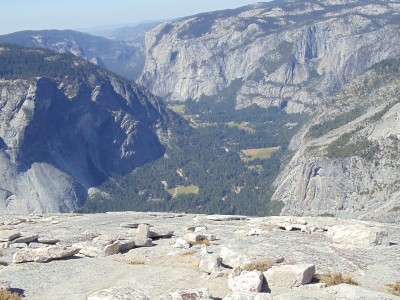
I wander around the top a bit (it’s a lot larger than you’d think from just the classical view of Half Dome), walk over to a few of the edges (but not too close, since I still have the backpack on), then sit down and eat a lunch of half-shredded tortillas and Nutella. Mm…
Now it’s time to head back down and finish out the day. The ropes are much more crowded on the way down, and the line of descending hikers frequently comes to a standstill. A few people hop to the outside of the ropes to get down faster, but I’m not willing to consider this with a fully-loaded backpack. I bide my time by taking some pictures of the descent and of the views during it.
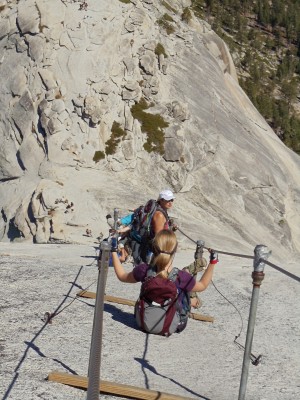
Once I’m past the ropes I descend much faster, well-aided by hiking poles and a quick step. (It’s actually too quick a couple times, as I roll each ankle several times these first several days, before they adjust to the demands I’m putting on them. I had intended to avoid this process by regularly ice skating in the weeks up to the trip, but multiple trips to relatives over the preceding months working remotely shot that plan all to pieces.) Once back on the JMT, I stop to refill on water at one point from a handy stream (climate this time of year is that of a desert, but strangely streams, lakes, ponds, and water in all forms is readily available almost all the time). The remaining hiking proceeds more slowly, and around 17:00 I feel tired enough to stop for an early dinner before hiking the remaining miles to Sunrise Camp.
Sunrise High Sierra Camp is run similarly to a White Mountains hut, and it’s one of a number of High Sierra Camps in Yosemite, albeit the only one directly on the JMT. Amazingly its pricing is even worse than that of the White Mountains huts. On the other hand, this camp has a free backpacker campground (no amenities except bear boxes and a pit toilet), so at least backpackers (whether thru-hiking or not) who don’t want to be gouged have a real choice. (If you weren’t an Appalachian Trail thru-hiker, and you were hiking in the White Mountains, I’m not actually sure where you’d stay in some parts of it if you didn’t want to overpay to stay in a hut.) I arrive at Sunrise just early enough to be able to nearly walk to the backpacker’s campground there without needing to ask for directions through twilight darkness. I walk through trying to find the extent of the campsites, and eventually I stumble to the end, find a rock ledge with a view over Long Meadow toward the east, and quickly head to sleep.
September 12
(16; 2 side; 30 total, 181 to go)
I’ve set my watch to wake me up sometime before sunrise, and I wake up on time today. As one would expect, the sunrise at Sunrise is very nice, if quite bright. After a breakfast eaten sitting on the rock ledge, it’s back on the trail heading trail-south but geographically north, hiking even before 8:00, surprisingly early for me.
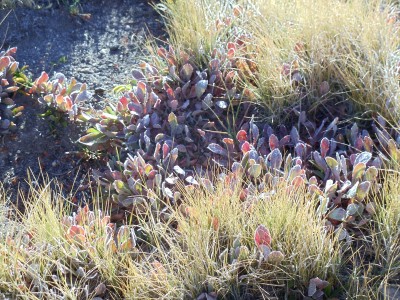
Today’s hiking is pretty easy. After some meandering through Long Meadow, it’s a short bit of hiking up, then some mountainside wandering, then passing through some valleys with assorted lakes and ponds, then a long, gradual descent down to Tuolumne Meadows and something vaguely like civilization. I don’t need to stop by Tuolumne Meadows, but the trail passes close to a road along which lies a grill and small store. I’m feeling hungry, and I could use some Gold Bond powder if I can find it in the store, so I hop off the trail and road-walk the mile to it. Lunch is a cheeseburger with fries and all the condiments I can get; I even eat the dill pickle that comes with it (only because I know I can use the energy). The store doesn’t have Gold Bond power, alas, but it does have something as magical: boxed win! Er, I mean, boxed wine! (I hear snobby readers saying “Quelle horreur!” as I type this. You know who you are.) I couldn’t have fit it in my bear canister a couple days ago, but I now have the space to make it work with a little effort, so I get a half liter of pinot grigio before heading back to the trail.
For whatever reason I find that I’m dragging a bit when I hit the trail again. It doesn’t help that the guidebook and signs are a bit unclear as to how to return to, and continue upon, the JMT. Nor does it help that my ankles are (both) in considerable pain from stumbling; I would likely be in trouble now if I didn’t have hiking poles to arrest my falls. I take it somewhat slowly heading south to enter Lyell Canyon, which isn’t a sheer canyon but rather four miles of essentially level trail along Lyell Fork toward the ascents and passes beyond. It’s getting late in the afternoon, but there’s no camping in the first four miles of the canyon, so I keep hiking to the trail junction just past the four mile limit.
The junction is a well-frequented camping area, and there are at least a couple dozen people around. I pick a spot near a few backpackers and their fire ring, eat dinner (chipotle-flavored salmon and Mexican rice, most excellent — because I’m just weird, the rather-heavy wine will wait until I arrive early enough somewhere to attempt to cool it before dinner), and shortly head to sleep.
…and that wraps up the first of several posts covering the entire JMT. With the number of pictures I’m taking, it’s clear the fewer days I batch up at a time, the better, as far as keeping post “height” reasonable goes. Thus you can expect at least four or five more of these posts to cover the roughly two weeks that remain of the trip and hike. Until next time…

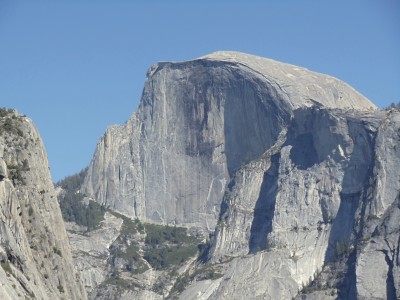
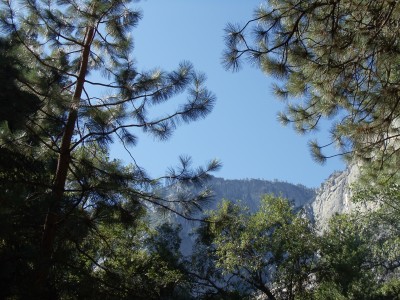
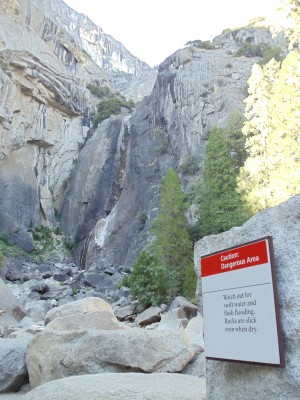
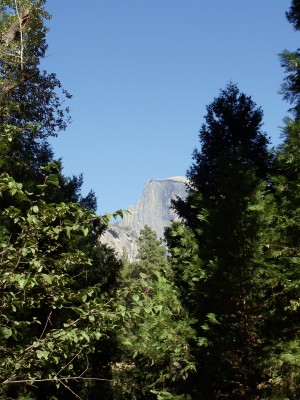
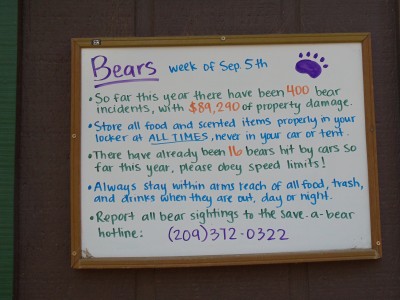




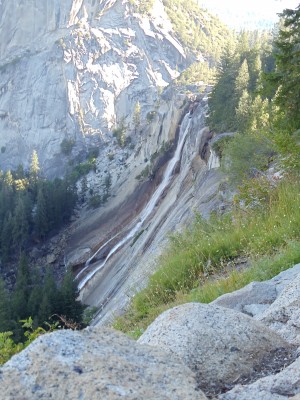





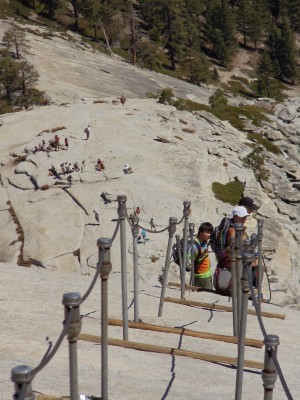

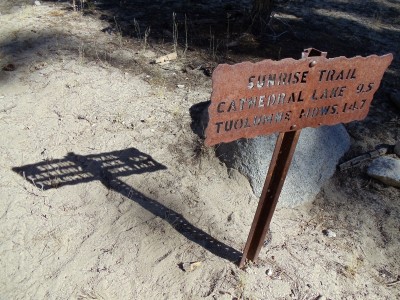


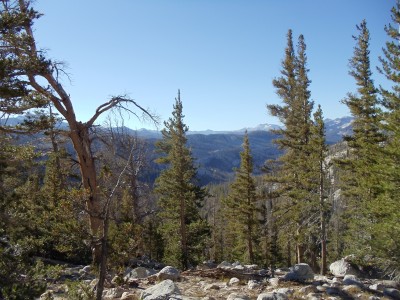

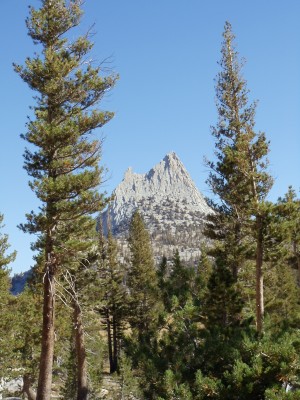
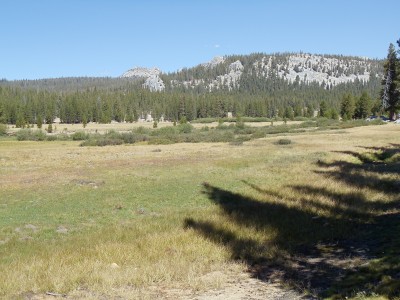


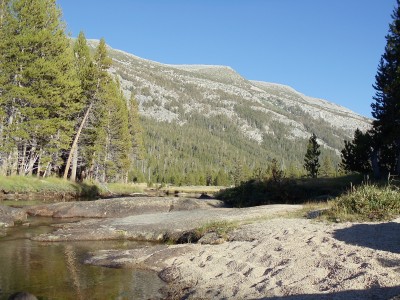
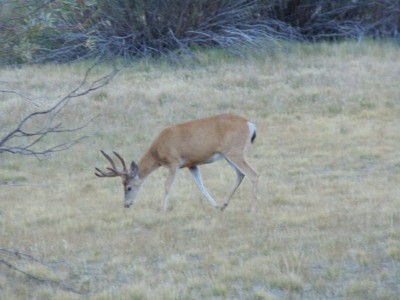
My husband Philip is currently hiking the JMT. I am posting photos of his locations along the way to “follow his trail” on FB. Would you be willing to give me permission to use some of your photos (he has not been able to send any photos yet) with credit line of your choosing &/or link to your page?
Tx,
Pamela
Comment by Pamela Venus — 25.08.15 @ 11:22
Sure, go ahead. A link back to the post/page containing the image is good enough, “source” or something more specific if you want for the link text.
Comment by Jeff — 12.09.15 @ 00:30